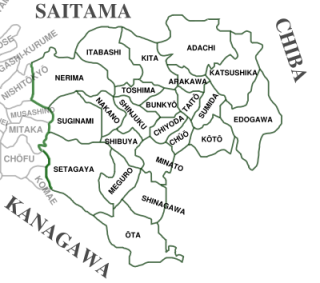Ota City General Info

The special wards of Tokyo are 23 municipalities that together make up the core and the most populous part of Tokyo, Japan. Together, they occupy the land that was the city of Tokyo before it was abolished in 1943. Within the country, this type of administrative division is unique to Tokyo. In Japanese, their formal name is "special wards", and collectively they are commonly known as the "twenty-three wards".
They are special because although they are autonomous local governments, they at the same time function seamlessly together as one large urban entity in central Tokyo. To this end, certain public services are handled by the government of the larger prefecture, whereas cities normally provide these services themselves. They include water supply, sewage disposal, and fire services. To finance the joint public services it provides to the twenty-three wards, the metropolitan government levies some of the taxes that would normally be levied by city governments, and also makes transfer payments to wards that cannot finance their own local administration.
The word "special" distinguishes them from the wards of other major Japanese cities. Before 1943, the wards of Tokyo City were no different from the wards of Osaka or Kyoto. On March 15, 1943, when the Tokyo city government and prefectural government merged into a single prefectural government, the wards were placed under the direct control of the prefecture. Thirty-five wards of the former city were integrated into 22 on March 15, 1947 just before the legal definition of special wards was given by the Local Autonomy Law, enforced on May 3 the same year. The 23rd ward, Nerima, was formed on August 1, 1947.
Since the 1970s, the special wards of Tokyo have exercised a considerably higher degree of autonomy than the wards in other cities, making them more like independent cities than districts. Each special ward has its own elected mayor and assembly.
In 2000, the National Diet designated the special wards as local public entities, giving them a status similar to cities. Since then, they have been calling themselves "cities" instead of wards in English, even though the Japanese designation of tokubetsuku is unchanged. They have also taken over certain public services metropolitan government, such as garbage collection and disposal.
The wards vary greatly in area (from 10 to 60 km²) and population (from less than 40,000 to 830,000), and some are expanding as artificial islands are built. Setagaya has the most people, while neighboring Ota has the largest area.
The total population of the twenty-three special wards was 8,483,140 as of October 1, 2005[1], about two-thirds of the population of Tokyo and a quarter of the population of the Greater Tokyo Area. The twenty-three wards have a population density of 13,800 per square kilometre (35,600 per square mile).
Today, Ota has a population of over 670,000 people in an area of just over 59 square miles. The City of Salem, MA, in comparison, has a population of over 42,000 people in an area of 8 square miles. Both communities border the ocean.

